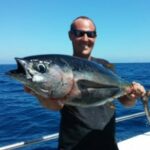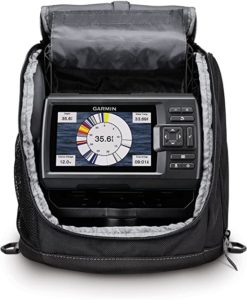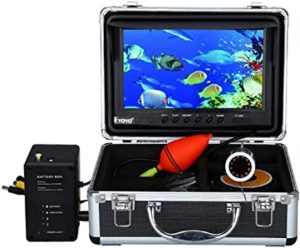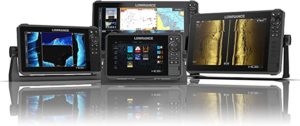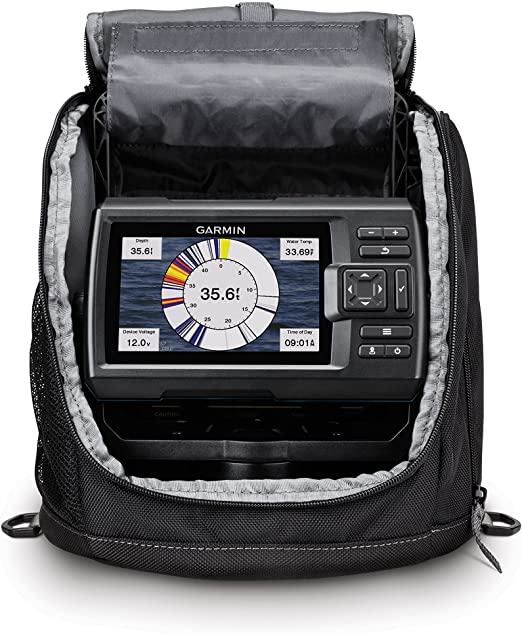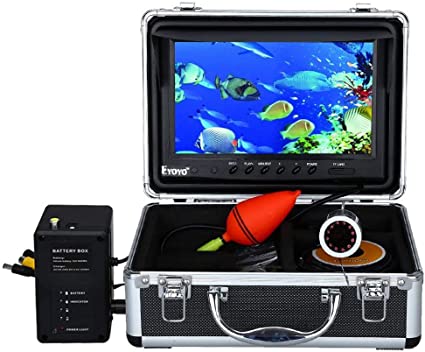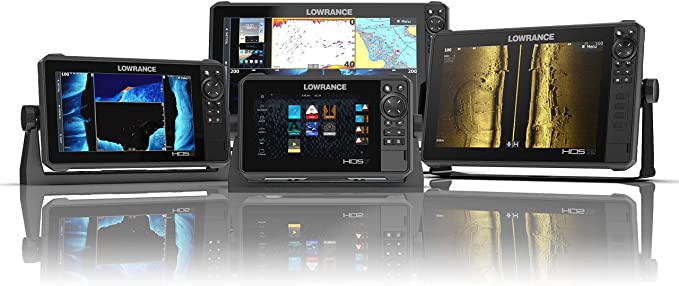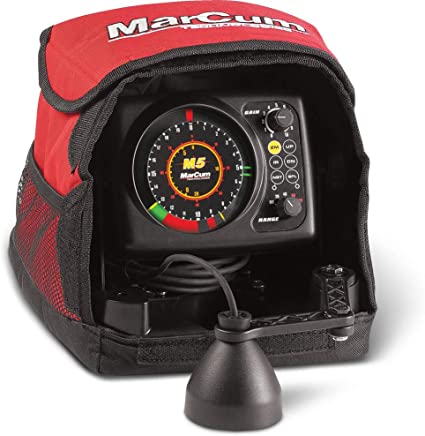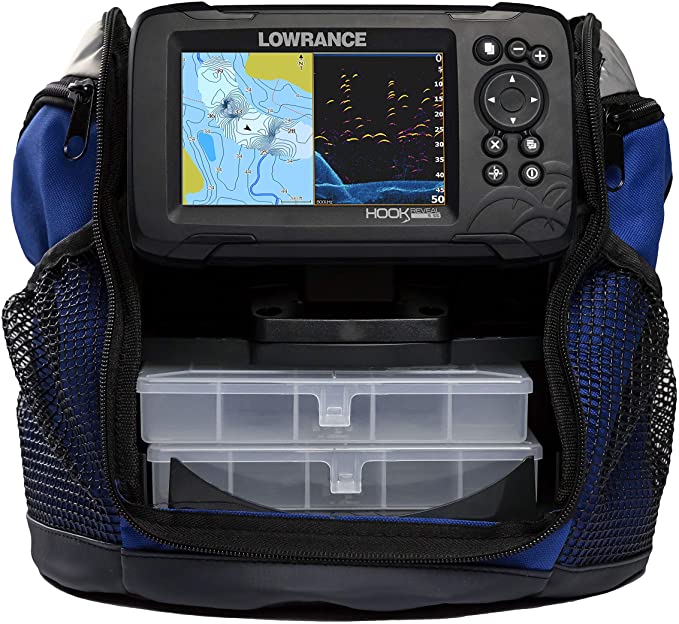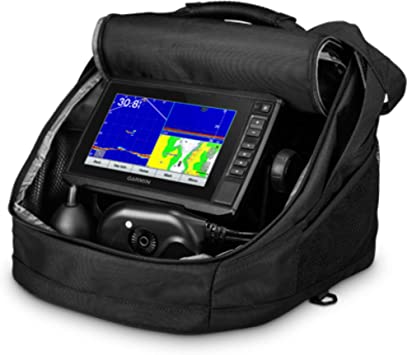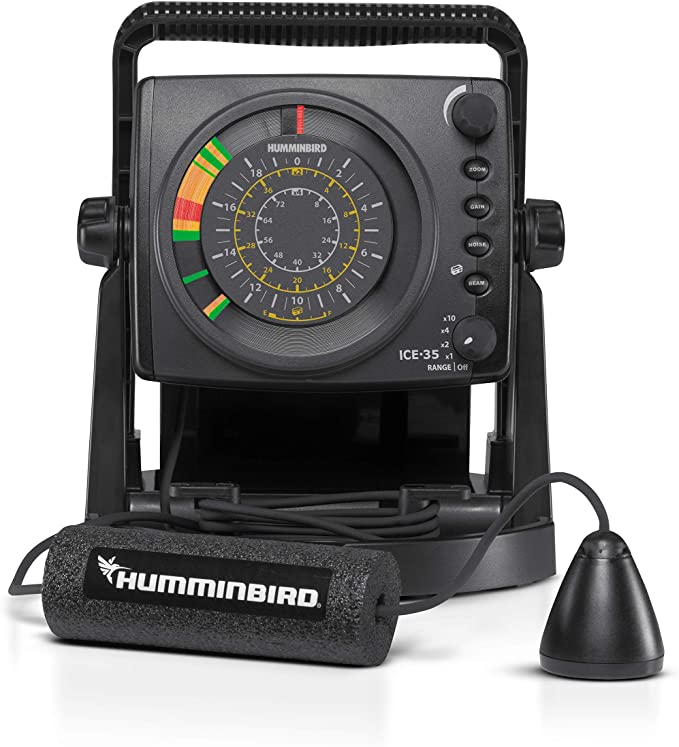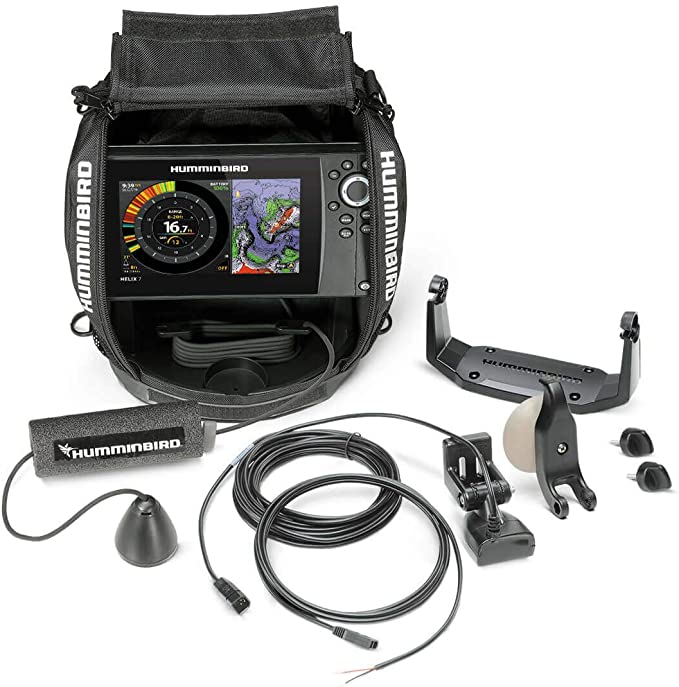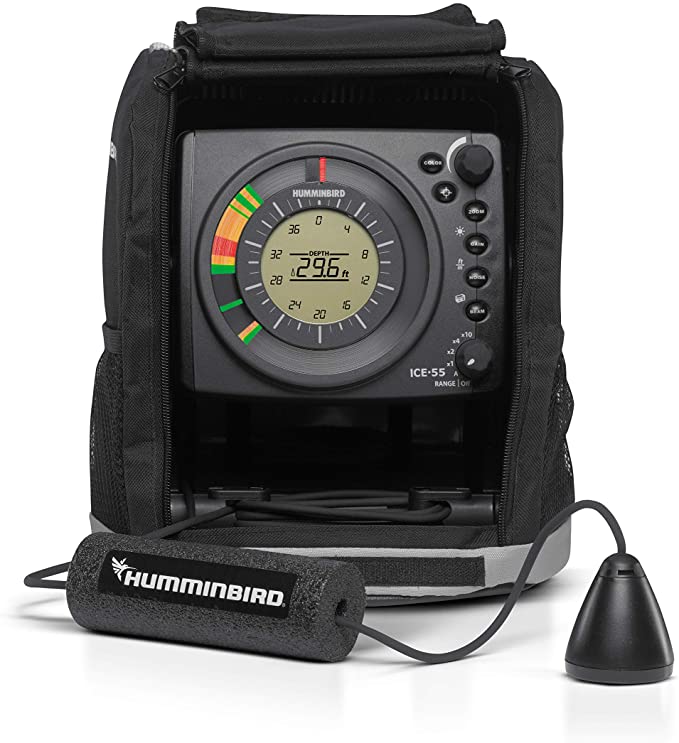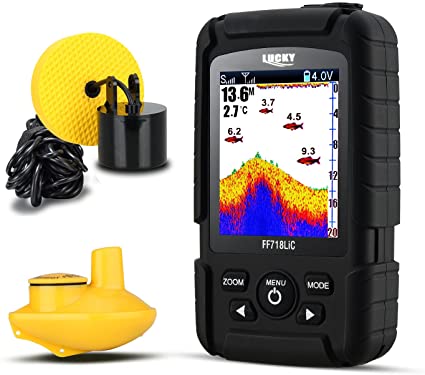I was skeptical about ice fishing once upon a time. Blindly jigging a hole in the ice hoping for a bite sounded a little too primitive. I had this image in my mind of my body being found looking like Jack Nicholson at the end of The Shining.
Well, thanks to today’s technology, ice fishing has become a more active sport. And this is mostly due to advancements in sonar and GPS. Some new models can map lakes and waypoints, have 2D imaging, even track fish movement and how they’re reacting to lures. Aside from an underwater camera for ice fishing, you can also use a fish finder to pick the perfect spot to drill your hole and set up your shelter or to drill your many holes for your homemade tip ups.
After using so many different ones that I’ve owned or shared with buddies, I have some insights for prospective buyers on the best fish finders for ice fishing. Available on Amazon, all here are great options to get eyes below the ice. From flashers to LCD sonars and infra-red cameras, these picks are sure to heat up your winter fishing (and if you’re interested in budget fish finders under $300, check out our other guide).
Best Fish Finder for Ice Fishing
Garmin makes some of the best underwater imaging products for "soft water" fishing. It was a no-brainer trying out their ice set-ups early on.
Check Today's PriceWhat I Like:
Mapping Software- No more guesswork, the built-in system stores up to 2 million acres worth of maps with contours so you can return to any honey-hole.
Bundle Package- For a modest price you not only get the 5” screen with the mount, transducer, and other hardware, but they throw in a carrying bag, foam float, documentation, and Garmin bumper sticker, too.
Know Before You Buy:
Battery Power- This package comes with a sealed lead battery, which has only about a 12-hour lifespan. Switching it out for a lithium one will increase this, however.
Ice-only Transducer- You’ll have to swap it out to make it ClearVue compatible. Sold separately.
Best Budget Fish Finder for Ice Fishing
Fishing cameras are a relatively new innovation. This one by Eyoyo has some nice features and for a lot less money than many other brands.
Check Today's PriceWhat I Like:
High-resolution Imaging- Flashers can be difficult to read for beginners, so 2D sonar imaging’s popularity has grown fast. Lowrance’s FishReveal system brightly lights up fish on the screen. The DownScan gives high-resolution details of bottom structure, too, painting an easily comprehensible picture.
Sonar Auto Tunes Itself- This finder already gives wide-angle and high-resolution sight thanks to Compressed High Intensity Radar Pulse (CHIRP) sonar. It also zooms in and out on its own as conditions and targets in the water change, freeing me to continue fishing.
Preloaded Maps- I don’t have to blindly fish new lakes. This model comes with thousands of preloaded maps with contours and features of U.S. water-bodies.
Know Before You Buy:
5″ Screen- It’s a pricey unit for a small interface. If you’re already used to a bigger screen, it’s hard to get used to quickly reading this one.
Best Premium Ice Fishing Fish Finder
I can buy a used car for less than the HDS-7 Live, but as an ice fisherman, I can't have as much fun. With a butter-smooth operating system and so many great features, it's one of the best out there.
Check Today's PriceWhat I Like:
Top-of-the-line Sonar And Imaging- It has the latest in CHIRP sonar technology, but adds one more “D” than most with 3D StructureScan, DownScan, even SideScan imaging. Whether I want to see the bottom or tightly packed schools of fish, it shows everything in high-resolution and clarity for an in-depth picture.
7-inch Screen Always Visible- I love Lowrance’s SolarMax screens for being readable under bright sunlight. But this gets bonus points for being designed for good visibility while wearing polarized glasses.
Hooks Up To My Smartphone- It’s Bluetooth compatible and connects easily to my phone- which I don’t tell my wife. But if there’s an emergency I’ll be notified, and if not an emergency, sorry, I wasn’t looking at my phone. It’s also a touchscreen for simple usability.
Speed And Power- It has a dual-core processor and runs the technology faster and smoother than most laptops I’ve owned. On the touchscreen platform, I bounce back-and-forth from live imaging to mapping without upload time or annoyance.
Know Before You Buy:
Add-on Costs- While it’s a stunningly functional piece of equipment, expect to pay more than its already high price to enjoy all the features. This means purchasing downloadable maps, but also a few extra steps to go through unlocking GPS if fishing outside of the U.S.
Also Recommended
MarCum makes flashers on the high-end side of the game. The M5L is climbing the price ladder a bit, but what it gives back in return makes it a solid investment.
Check Today's PriceWhat I Like:
Interference Rejection- MarCum’s patented system gets rid of interference caused by other sonar systems. This is a big deal as fishermen crowd the ice in peak season.
3/4 Inch Target Separation- No fish worth catching can remain hidden beneath the cone of this sonar. The TrueColor lighting system display also makes it easy to discern bottom clarity, your lure, and everything in-between.
Lithium Battery- Stay out longer on the ice while pumping out 2500 Watts with the BRUTE 12 volt 9 amp lithium battery and charger.
Know Before You Buy:
11 Pound Weight: This is a sophisticated product, but it’s also on the high-end in weight compared to other fish finders. That makes me not want to carry it, some days.
Also Recommended
Lowrance is a proven brand in the field. Their HOOK Reveal 5 is a good investment because it comes with an ice transducer, but works easily on a boat, too.
Check Today's PriceWhat I Like:
High-resolution Imaging- Flashers can be difficult to read for beginners, so 2D sonar imaging’s popularity has grown fast. Lowrance’s FishReveal system brightly lights up fish on the screen. The DownScan gives high-resolution details of bottom structure, too, painting an easily comprehensible picture.
Sonar Auto Tunes Itself- This finder already gives wide-angle and high-resolution sight thanks to Compressed High Intensity Radar Pulse (CHIRP) sonar. It also zooms in and out on its own as conditions and targets in the water change, freeing me to continue fishing.
Preloaded Maps- I don’t have to blindly fish new lakes. This model comes with thousands of preloaded maps with contours and features of U.S. water-bodies.
Know Before You Buy:
5″ Screen- It’s a pricey unit for a small interface. If you’re already used to a bigger screen, it’s hard to get used to quickly reading this one.
Also Recommended
This Garmin Panoptix bundle comes with a price-tag that will definitely break the ice. But the great features might make it the last set-up you'll ever need. It comes with the GT10HN-IF ice fishing transducer, ECHOMAP Plus 73cv with three different sonars, as well as a carrying case to protect the investment.
Check Today's PriceWhat I Like:
3 Sonars- I’d expect versatility for this amount of money. The Panoptix does come with a transducer for ice as well as mounting on a boat. That’s the narrow beamed CHIRP as well as Garmin’s LiveVu Forward and Down system.
Preloaded Maps- It’s a wonderful feature on any fish finder, but this one has an astounding 17,000 preloaded onto its LakeVu HD system. These maps can also appear simultaneously on the 7-inch touchscreen with flasher and Panoptix views.
Multi-frequency CHIRP- It sends them all at once and deciphers them upon return. This is real-time distinguishing that allows me to play around with it less while I fish more.
Know Before You Buy:
Weighs 25.7 Pounds- Of course, this is the weight of the entire bundle, which includes the mount, 12ah battery and charger, two transducers, and carrying case. But you’ll feel most of that carrying what you’ll need out onto the ice.
Also Recommended
A tried-and-true flasher is the option most ice fishermen seem to go for. This one by Humminbird has a great interface as well as the reliability you can depend on. For the modest price, it's an option worth looking into.
Check Today's PriceWhat I Like:
Fiber Optic Display In 3 Bright Colors- I like easy readability, and the crispness on this flasher really shines. I never lose contact with my lure or the lake bottom.
Adjustable Depth Range Sonar- There are four zoom settings allowing for a cleaner picture up to 200 feet deep. It also has dual beam sonar to hone in on either a wide view or extra definition, so I’m never stumped as to fish activity or bottom structure.
Built To Last- This flasher will operate at peak performance even when temperatures dip down to -20 degrees. Humminbird also offers a 2-year warranty, but I’ve seen this model last many years longer.
Know Before You Buy:
Limited Battery Life- The modestly priced fish finders tend to suffer this problem. The battery that comes with it will run for only about 7 hours.
Also Recommended
The Humminbird Helix series is wildly popular, and for good reason. Here is a package deal that comes with all the necessary hardware to enjoy it on the ice or in a boat.
Check Today's PriceWhat I Like:
Real-time Jig Action- This option gives a sonar ping pattern while jigging. When set to Jig Charge Mode, it’s a real-time image of vertical jigging. It tracks depth change phenomenally well and makes ice fishing like a video game.
Detail Enhancement Up To ¾ Of An Inch- The dual spectrum sonar is a game-changer for targeting fish. Everything is easily distinguishable, from bait, lures, structure, and individual fish.
It Can Be Used Around Other Fishermen’s Sonar- The CHIRP interference rejection works as advertised. The old problem of sonar being jammed by signals from other equipment around is no more.
Know Before You Buy:
Battery Life Is Surprisingly Short- Expect this fish finder to last about 7 to 9 hours out on the ice.
Also Recommended
The Humminbird Ice Series flashers are considered by many to be the best sonar systems available to consumers. The Ice-55 is the largest and most powerful to come out after the Ice-35 and Ice-45 models.
Check Today's PriceWhat I Like:
More Power, Longer Life On The Ice- The Ice-55 has a 9 AMP hour battery and charger. Both the 35 and 45 in Humminbird’s Ice Series previously only had a 7amp. This equates to more time on the ice reeling in slabs using the much-lauded Humminbird sonar system.
Ultra-bright Fiber Optics- Being able to see the colors on a flasher’s display and read it is critical. The sunlight can drown these out on a lot of other brands. The ultra-bright sonar returns here always show clearly the three most important things: bottom, fish, and lure.
Mark Exact Depths- With its Ice Target Line feature I can keep track of where the fish are and have my lure in position. It’s displayed by a purple line on the flasher’s interface.
Know Before You Buy:
Replacements And Repairs Are Expensive- Humminbird offers a 2-year limited warranty on all Ice Series flashers. But if something goes wrong and it has to be sent in for repairs, expect to pay a minimum of $175. A lot of times with this model it could just be the transducer itself that needs replacing. This will cost about $75.
Also Recommended
Ice fishing sonars aren't cheap. The technology is still relatively young and I wouldn't want to depend on anything cheap, anyways. But this model by LUCKY is available on Amazon for under $200 and has some surprising value along with functionality.
Check Today's PriceWhat I Like:
Gives Surprisingly Good Depth Readings And Picture- The 2.8 inch LCD monitor is tiny, but the color enhancements plus what it shows delivers a rather good picture. I found it very accurate at over 40 feet and showed weed beds (in green) nicely. Each fish has its own depth markings, water temp is listed, and, overall, Lucky found a way to save space on this small setup and still relay important info.
Has A Long Battery Life- I suppose for such a simple gadget it doesn’t need to throw off a lot of juice. It’s advertised to work up to 10 hours, but I was surprised to see it still running a while longer. This package on Amazon doesn’t come with a wall charger, but it has USB ports to get that also allow it to charge while using.
Know Before You Buy:
Sonar Will Be Wiped Out By Interference: When using this around other sonars it became very unstable accuracy-wise. This was to be expected, but its portability seems to inspire some lone trekking out on the ice anyhow. It’s a sturdily built little gadget that works when not around crowds of other fishermen with their own equipment. I still recommend it as an entry-level or budget-friendly way to read beneath the ice.
How To Find The Best Fish Finder For Ice Fishing
If you live in an area where rivers and lakes become frozen during winter, the best option you have is ice fishing. However, you must have the right gear (to catch the fish) and equipment (mainly to stay warm), such as a fish finder, to ensure that you take a good catch home. The market is filled with different fish finders, and choosing the best ice fishing finder may be challenging. That is why you need to make some considerations to help you make an informed decision.
Price Range
As a buyer, your budget and financial abilities will determine the kind of finder you will get. This equipment comes at different prices on the market. The price differences are brought about by the various fish finder brands, their specific features, and their quality. The best fish finder is one that falls within your budget.
Imaging Type
It is also essential to know whether you want a black & white screen or a colored one. The majority of gadget screens today are colored because they show the images better in bright light, and they are outstanding in low light. Black & white screens are also available, but their imaging is not as precise. Colored displays are the best, but you can go for black & white if that is what you can afford. After all, something is better than nothing.
Power Source
The wattage of the finder you want depends on the depth of the waters you will be fishing in. Gadgets with a high wattage are ideal for deep waters, while those with a lower wattage should be used in shallow waters. This is so because your device works by translating the sonar waves from its transducer.
Display Quality
The image quality of a fish finder is a serious consideration – it is the electronics you will be using to know where the fishes are. The first things to check out when considering the imaging type are the finder’s resolution and the pixels of its screen.
Portability
A portable finder would be an ideal option, especially if you ice fish a lot. They are easy to set up, carry around, and power off. However, you will need a solid battery to last you through a fishing session.
Frequency
You will find ice fish finders with either single, dual, or multiple frequencies on the transducer. High frequencies give clear information, which helps enhance your ice fishing experience. Additionally, finders with high frequencies have the least background noise and the clearest resolution. However, such devices are not as ideal for great depths as those with low frequencies.
Ease of Use
If you have the technical know-how to handle an ice fishing finder, you may consider getting one with extra features. If you lack technical knowledge, you should consider buying a simpler gadget, for instance, one with automatic functions and a larger display for easier reading.
Transducer
A transducer plays a pivotal role in receiving and translating the sonar waves for your finder. Transducers have different mounting requirements. Transom mounts are the easiest to install, but the thru-hull mount is the best for big boats when it comes to traditional fishing. The transducer’s equipment also matters a lot. The plastic transom is the best material choice if you are an enthusiast or a casual fisherman.
Water Resistance
The level of an ice fish finder is measured using JIS and IPX ratings. It is ideal to choose a gadget with high water resistance so that it does not get damaged by any water that splashes on it—the levels of water resistance range from 4 to 8. The rating of the fish finder you choose will determine where and how you will be using your unit.
FAQs
What is the difference between a fishing finder and a fishing flasher?
A fish flasher and finder have some differences, especially in their displays. Flashers have larger and multicolored displays that show you everything, including the sea bottom, your bait’s movements, and fish presence. Finders use graphs on their display, although the newer models have an RTS (real-time sonar) window to the right of the chart.
How do I install an ice fishing finder?
The installation of an ice fishing finder is not complicated. First, you have to identify the best spot for mounting the transducer. Next, you should test-run the wires before screwing in the transducer. This includes the cables running from the transducer to the central unit and those running from the unit to the battery. The next step is to mount the transducer on the ice. Finally, run the wires and mount the fish finder to start identifying the fish’s location.
How does a fish finder work?
Before you start using a fish finder, you must ensure that the transducer is as vertical as possible below the ice surface. Use your depth finder to find the bottom and lower your bait. The lure will become more apparent as it goes deeper, because the cone angle of your finder widens with depth. You will only see the fish below you on the finder’s display.
Do I need a different kind of fish finder for ice fishing than regular fishing?
Yes. Most recent fish finders can be adjusted for use in ice fishing. You just need to have a portable power supply and understand how to level the transducer in an ice hole.
In Summary
Ice fishing is and has been an enjoyable activity for a long time. However, it can be challenging to get a good catch, especially if you do not have an ice fishing finder. These gadgets are widely available on the market, and that is why the information explained above is geared towards helping you pick one that fully satisfies your needs.
As an Amazon Associate, Fishermen's Angle earns from qualifying purchases. We get commissions for purchases made through links in this post.
